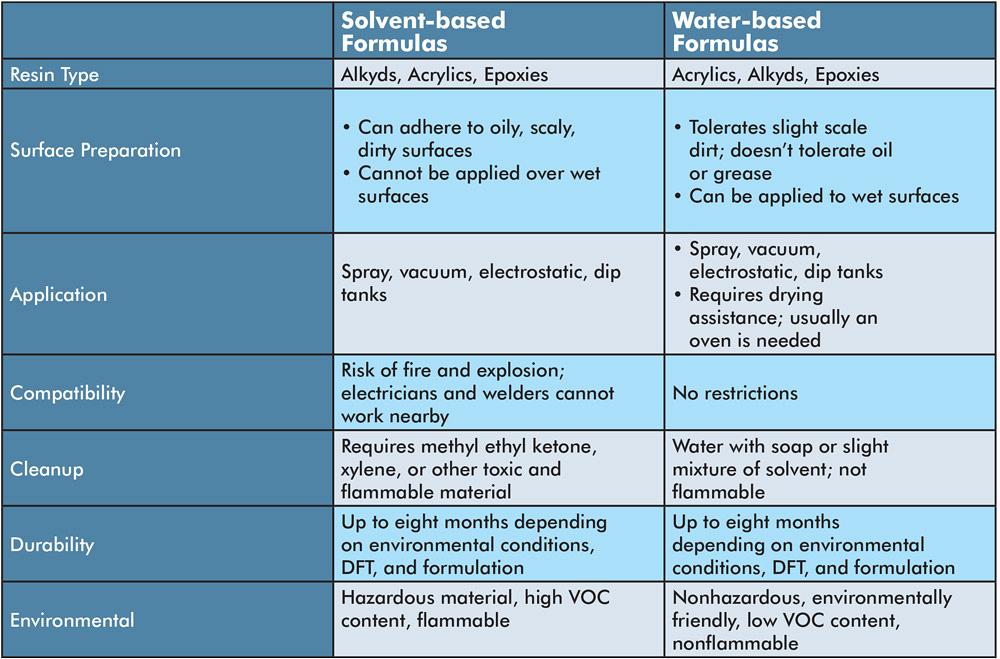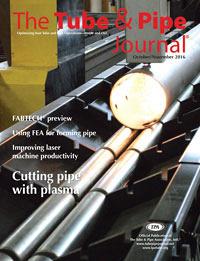Business Development Manager, Tube and Pipe
- FMA
- The Fabricator
- FABTECH
- Canadian Metalworking
Categories
- Additive Manufacturing
- Aluminum Welding
- Arc Welding
- Assembly and Joining
- Automation and Robotics
- Bending and Forming
- Consumables
- Cutting and Weld Prep
- Electric Vehicles
- En Español
- Finishing
- Hydroforming
- Laser Cutting
- Laser Welding
- Machining
- Manufacturing Software
- Materials Handling
- Metals/Materials
- Oxyfuel Cutting
- Plasma Cutting
- Power Tools
- Punching and Other Holemaking
- Roll Forming
- Safety
- Sawing
- Shearing
- Shop Management
- Testing and Measuring
- Tube and Pipe Fabrication
- Tube and Pipe Production
- Waterjet Cutting
Industry Directory
Webcasts
Podcasts
FAB 40
Advertise
Subscribe
Account Login
Search
Eliminating solvents, reducing VOCs
Water-based coatings make the pipe industry greener, safer
- By Martin Tellez
- October 26, 2016
- Article
- Tube and Pipe Production

Figure 1
A solvent-based pipe coating can have a volatile organic compound (VOC) content that is more than six times that of a water-based pipe coating by weight. Source: Quaker Chemical
Pipe producers often apply a liquid coating at the end of the manufacturing process to protect the products during transport and storage. Designed to provide a high degree of outdoor protection for up to one year, these coatings endure marine environments, exposure to sunlight, and significant moving and handling. Until recently, most coating products available in the pipe market were solvent-based, which provided a range of choices in durability. They also were favored because they complied with the industry-based technical requirements that established the level of adhesion and corrosion resistance.
Solvent-based coatings tend to have the most competitive pricing structure because they are manufactured from generic resins. Application methods include airless, air-assisted, and brush systems. Their versatility and ease of application have solvent-based coatings the technology of choice for many years.
The downside is that solvent-based coatings are not compatible with today’s demands for greener technologies. The manufacture of coatings with high volatile organic compound (VOC) content poses health hazards and pollution risks. VOCs also contribute to the greenhouse effect.
Regulations have tightened in recent years. Since 2007 the European Union (EU) Solvent Emission Directive 1999/13/EC (SED) has imposed a solvent reduction approach on all installations that produce more than 5 tons of VOCs annually. While U.S. regulations aren’t as stringent as those in Europe, they too have been tightening.
Since the creation of recent laws and taxes that regulate the emission of VOCs, chemical manufacturers have been trying to reduce the environmental impact by lowering VOC levels in their products. These developments align with the global trend toward more environmentally friendly products for chemical, petrochemical, and industrial producers like tube and pipe manufacturers.
The need for more environmentally friendly technologies has been a critical driver for new developments in water-based industrial coatings in many industries (see Figure 1).
Water-based coatings are similar in composition to typical solvent-based coatings, except that water replaces almost all of the solvent as the carrier. Water-based formulas contain about 65 to 70 percent water, with a small amount of solvent to facilitate dispersion and enhance the coalescence properties of the resin. The three main types of water-based formulations in the industrial market are:
- Water-soluble or water-reducible coatings.
- Colloidal or dispersible coatings.
- Emulsions (latex).
Coating Properties Comparison
One of the biggest differences between solvent- and water-based coatings is the quantity of VOCs. In some cases, water-based coatings contain no VOCs at all (see Figure 2).
Properties can vary depending on resin type, solids content, and even the coalescing solvent. However, most of them provide a minimum set of performance characteristics:
- Adhesion (ASTM D3359): This test consists of cutting the film with a commercially available tool and using a special tape to try to remove the coating. The resulting score is used widely used in industry, especially on applications that require a UV coating.
- Corrosion performance (ASTM B117): This accelerated test measures the time it takes a coating to fail when exposed to a saline environment. A general fail point is around 5 to 15 percent. This test is used widely in the industry with requirements that vary from 100 to 400 hours.
- Outdoor performance: This test usually is performed at the plant after a functional trial on the production line. The time outdoors varies depending on environmental condition, application thickness, and customer needs.
Solvent-based Coatings. Two key advantages to solvent-based coatings concern their drying characteristics. First, they provide waterproofing protection immediately after application. Second, they are less sensitive to cold temperatures while drying, which helps ensure proper coalescence as they dry.

Figure 2
Whether measured by weight or by volume, the VOC content of water-based coatings is substantially less than that of solvent-based coatings.
The downsides are application, health, and fire risks. First, they cannot be applied onto wet pipe surfaces, nor should they come into contact with plastics, which they damage. Second, the user must wear protective gear when handling them and work in a well-ventilated area when applying them. Last, rags used to wipe alkyd coatings can self-ignite as they dry, so they must be handled and stored properly to prevent fire. All aromatic solvents used are carcinogenic and highly flammable.
Water-based Coatings. Water-based pipe coatings tend to be nontoxic, nonflammable, and have no significant solvent fumes or emissions to consider. Water-based coatings also are more likely to be compatible with hoses and plastic surfaces than solvent-based coatings. Also, they can be applied to damp pipe surfaces and, as long as the coating hasn’t dried, water can be used for cleanup.
However, water-based coatings are sensitive to surface conditions; specifically, they don’t adhere well to oily or greasy surfaces. Also, they’re susceptible to viscosity variations and cold temperatures, and they require drying times in proportion to the relative humidity. Drying systems and surface preparation can reduce drying times.
When application systems are properly optimized, water-based coatings can be a good alternative to solvent-based coatings (see Figure 3).
Economic Considerations
Solvent-based coatings usually have higher solids content than water-based coatings. As seen in Figure 4, a typical alkyd solvent-based coating has 35 percent solids by volume and covers 337 square feet per gallon. This is based on 60 percent application efficiency, which is average for the traditional drum systems still commonly used in industry. A typical water-based acrylic coating at the conventional efficiency, about 85 percent, covers about 382 sq. ft./gal.
A key difference is the VOC content released into the atmosphere. The solvent-based technology releases 65 percent of its VOCs; the water-based coating releases just 5 percent of its VOC content, and in many cases even less. In a plant that has a low maximum VOC threshold, the only way to comply is to use a low-VOC coating.
Other cost comparisons:
- A water-based coating line can require additional equipment and use additional energy. An induction heater or an oven can be added to reduce the drying time and increase productivity. The additional capital and energy consumption change the cost equation.
- Solvent-based coatings present a fire hazard, so a sprinkler system and higher insurance premiums are additional costs. Another potential cost is the fine associated with exceeding the VOC emission limits.
While solvent-based coatings have lower applied costs, they come with higher operating costs, increased risks to worker health and safety, and greater environmental impact.
A Look to the Future
In recent years, environmental concerns have taken on greater importance. These concerns have led to more restrictive laws and put greater focus on technologies that are considered potentially harmful to the environment and alternatives that have less impact.
Although water-based coatings have some shortcomings, improvements in their efficiency, quality, and performance have made this product family more competitive relative to solvent-based coatings for the tube and pipe industry.
Water-based coatings are likely to become the technology of choice in the tube and pipe industry.
About the Author
Martin Tellez
One Quaker Park, 901 Hector St.
Conshohocken, PA
610-832-4000
About the Publication
Related Companies
subscribe now

The Tube and Pipe Journal became the first magazine dedicated to serving the metal tube and pipe industry in 1990. Today, it remains the only North American publication devoted to this industry, and it has become the most trusted source of information for tube and pipe professionals.
start your free subscription- Stay connected from anywhere

Easily access valuable industry resources now with full access to the digital edition of The Fabricator.

Easily access valuable industry resources now with full access to the digital edition of The Welder.

Easily access valuable industry resources now with full access to the digital edition of The Tube and Pipe Journal.
- Podcasting
- Podcast:
- The Fabricator Podcast
- Published:
- 04/16/2024
- Running Time:
- 63:29
In this episode of The Fabricator Podcast, Caleb Chamberlain, co-founder and CEO of OSH Cut, discusses his company’s...
- Industry Events
16th Annual Safety Conference
- April 30 - May 1, 2024
- Elgin,
Pipe and Tube Conference
- May 21 - 22, 2024
- Omaha, NE
World-Class Roll Forming Workshop
- June 5 - 6, 2024
- Louisville, KY
Advanced Laser Application Workshop
- June 25 - 27, 2024
- Novi, MI
































